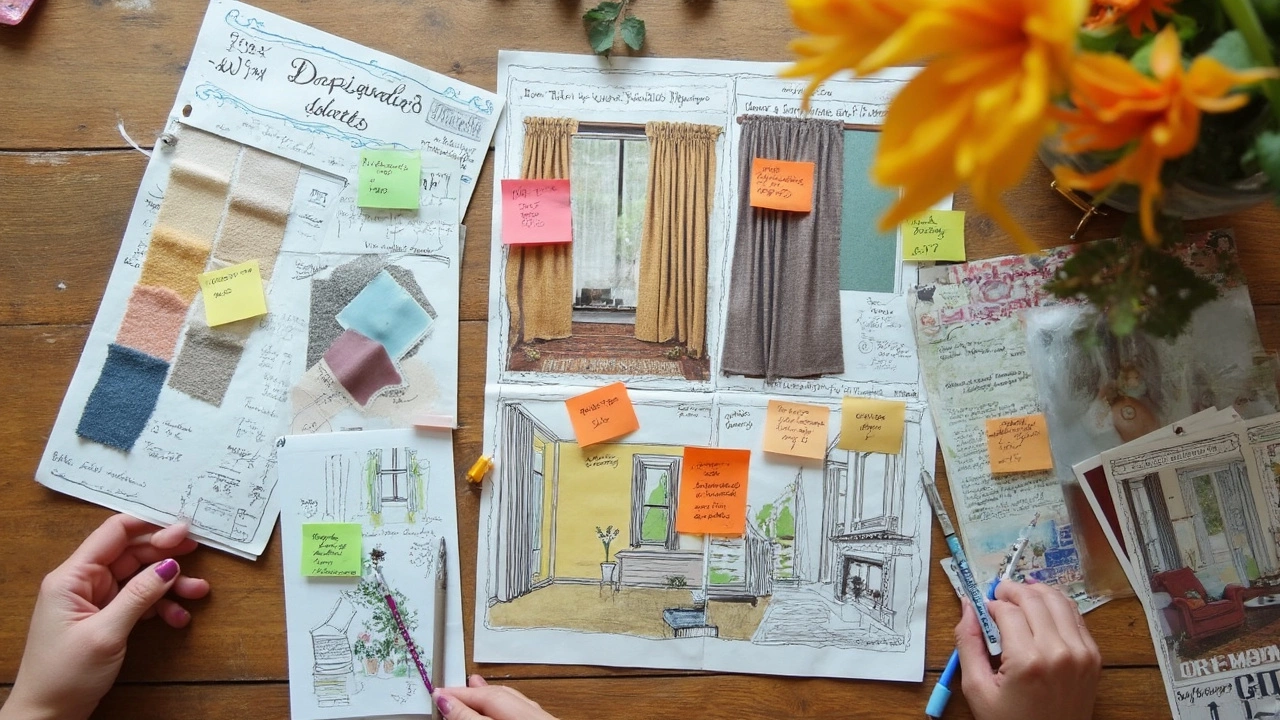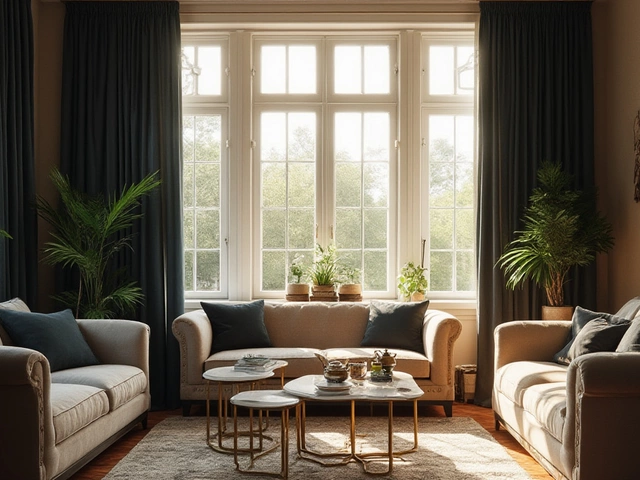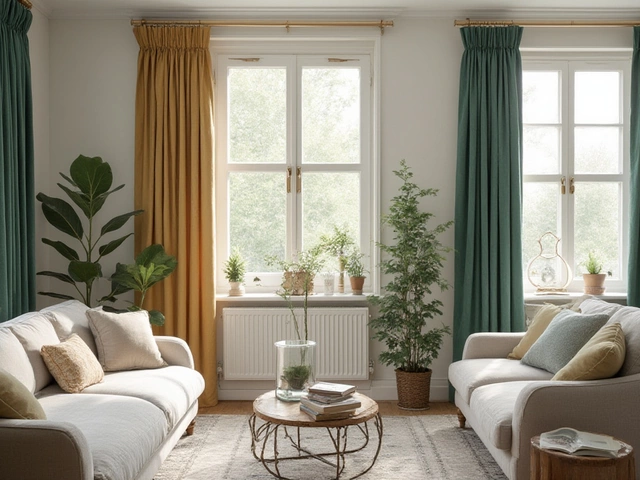If you’ve shopped for window treatments, you’ve probably wondered why drapes seem to cost more than curtains. Is it just marketing, or is there a real difference in what you get for your money? People often use the words 'curtains' and 'drapes' like they mean the same thing, but in the world of home decor, they don’t. That difference plays a big role in how much you end up paying.
Let’s be real: most folks just want their room to look good, block out weird sunlight, and not destroy their paycheck in the process. But sometimes those subtle design choices—the extra fabric, the lining, the hardware—creep up and double the price before you know it. So, if you’re thinking, 'Do I really need drapes, or will curtains do the trick?' you’re already way ahead of most shoppers. That’s where knowing what you’re actually buying makes all the difference.
- Curtains vs. Drapes: What’s the Difference?
- Why Drapes Usually Cost More
- Price Factors: Fabric, Lining, and Length
- Design Choices to Save (or Spend) Your Money
- Shopping Smarter: When to Splurge or Save
Curtains vs. Drapes: What’s the Difference?
First things first—let’s clear up why people mix up curtains and drapes all the time. They both cover windows and look classy, but they’re not the same thing. Here’s the quick breakdown: curtains are made from lighter fabrics like cotton, linen, or polyester and are often sold in pairs. You see them everywhere—living rooms, kitchens, bedrooms—because they’re pretty easy on the eyes and the budget.
Drapes, on the other hand, are the heavyweight champions in window treatments. They’re thicker, usually lined, and made from dense fabrics such as velvet, brocade, or heavy polyester blends. When folks want blackout power or just a more “fancy hotel” vibe, they’ll go for drapes. You usually find them touching the floor, sometimes even puddling at the bottom for that dramatic look.
Here’s how it usually stacks up:
- Curtains: Lighter, unlined or lightly lined, more casual, often cheaper
- Drapes: Heavier, lined, tailored, blocks light better, looks more formal, usually pricier
Funny enough, the industry even splits where you’ll find each kind. Try searching for ready-made window treatments? Curtains will dominate. Looking at custom or high-end design catalogs? There’s where drapes rule.
| Feature | Curtains | Drapes |
|---|---|---|
| Weight | Light | Heavy |
| Typical Fabric | Cotton, Linen, Polyester | Velvet, Brocade, Heavy Polyester |
| Lining | Optional or None | Almost Always Lined |
| Formality | Casual to Semi-Formal | Formal |
| Price Range (per panel) | $15–$50 | $60–$300+ |
If budget’s your main concern, curtains usually win out. If you’re going for energy savings or noise reduction, lined drapes do a better job. Some people even layer them—curtains for style, drapes for function. The point is, knowing this difference saves you both time and cash—and makes you sound like you really know your window treatments when you’re shopping.
Why Drapes Usually Cost More
This surprises a lot of people, but drapes aren’t just curtains with a fancier name. The cost difference comes down to what you’re actually getting—and honestly, it all makes sense once you look at the details.
First, drapes are almost always made with heavier, more expensive fabric. While curtains use lighter materials (think cotton or polyester blends), drapes often use velvet, brocade, or lined silk. That bump in quality shows up right on the price tag. On top of that, drapes almost always have a lining—sometimes two. This lining doesn’t just make the window look good; it blocks light and helps keep rooms warmer or cooler, meaning you’ll shell out a few extra bucks for that insulation power.
Here’s where it gets real: the way drapes are made adds more cost. They usually run from the ceiling to the floor (sometimes even puddling on the ground for a dramatic look), so you pay for all that extra fabric—sometimes double what you’d use for basic curtains. More fabric means higher costs in both materials and shipping.
Let’s break down the average costs just to see where the difference lands:
| Window Treatment | Average Price per Panel |
|---|---|
| Curtains | $20 – $75 |
| Drapes | $70 – $200+ |
Hardware is another sneaky cost. Drapes usually need heftier rods and special hooks, which don’t come cheap. Add the fact that most custom drapes require professional installation, and you can see why the final bill jumps fast.
So, to sum it up: heavier fabric, fancy linings, extra length, pricier hardware, and some behind-the-scenes labor juice up the cost. If you want blackout, noise-reduction, or serious temperature control, drapes are often the only way to get those features, but you’ll definitely pay for the upgrade.

Price Factors: Fabric, Lining, and Length
Here’s where the price game between drapes and curtains really heats up. The materials you pick, whether you add lining, and even just how long the panels are—these can all beef up the bill.
Fabric is the biggest cost driver. Drapes often use heavier materials like velvet, brocade, or thick cotton to make them look and feel rich. Curtains tend to stick to lighter fabrics like sheer polyester or simple cotton blends. The difference can be wild: one yard of nice velvet can cost anywhere from $30 to $100, while basic unlined cotton for curtains is often under $10 a yard. Multiply that by several yards for every window, and the price gap adds up fast.
Let’s talk lining. Almost all real drapes have a backing—or even double or triple layers—while most curtains don’t. Lining doesn’t just look nice; it keeps out sun, helps control temperature, and improves the "hang" of the panel. That means more fabric and more labor. Blackout or thermal linings cost more, and they’re usually only found on drapes. A 2024 industry survey found that fully lined drapes run on average about 30–50% higher in price than similar unlined panels.
Then there’s length and size. Drapes are meant to reach the floor—sometimes even puddle—so you’re buying extra feet of fabric per window. Standard curtain panels often hang just above the sill, and that cuts costs. Custom-sized drapes, which are tall enough for high ceilings or wide windows, cost even more because you’re paying for extra fabric and usually custom work.
| Material | Typical Cost per Yard | Common Use |
|---|---|---|
| Polyester Sheer | $6 – $12 | Curtains |
| Cotton Blend | $8 – $20 | Curatins & Simple Drapes |
| Velvet | $30 – $100+ | Drapes |
| Lining (Blackout) | $8 – $25 | Mainly Drapes |
So, when you see a sticker price that makes you blink, check what’s hiding in the details. If those drapes have thick fabric, quality lining, and stretch from ceiling to floor, you’re looking at the reasons why your wallet feels lighter.
Design Choices to Save (or Spend) Your Money
This is where most people get stuck: trying to match their taste with their budget. Small tweaks in your drapes or curtains choice can seriously shift how much you pay—and how your room looks.
Let’s break it down with the real stuff that makes the price tag go up or down:
- Fabric quality: Thicker, heavier materials like velvet or brocade shoot costs way up, especially for drapes. If you want to save, look at cotton blends or polyester—these often look great and last without killing your bank account.
- Lining and insulation: Fully lined or blackout options add around 25-50% more per panel. They’re popular for bedrooms or blocking streetlights, but lining is optional for basic curtains. No lining equals cheaper—and brighter—rooms.
- Hardware: All those fancy rods, tiebacks, and rings aren’t usually included. Simple curtain rods are cheap, but heavy drapes need heavy-duty hardware, which means more cash.
- Length and width: Floor-to-ceiling drapes use way more fabric than classic curtains, especially if you want those dramatic puddles on the floor. More fabric equals more money—every single time.
- Custom vs. pre-made: Custom drapes can cost double—even triple—compared to box-store curtains. If the fit doesn’t have to be exact, pre-made panels are the way to go to save cash.
Here’s a quick look at average prices, just so you have a ballpark:
| Window Treatment | Average Cost per Panel |
|---|---|
| Pre-made Curtains | $20 - $60 |
| Pre-made Drapes | $50 - $150 |
| Custom Drapes | $200+ |
A few practical tips if you want to save money but not skimp on style:
- Pick light materials and skip the lining if you don’t need blackout.
- Go for shorter panels or standard window sizes—odd sizes always cost more.
- Check out discount retailers or online outlets for overstock deals.
- If you’re up for it, consider buying fabric and having a local tailor sew your panels.
The bottom line: fancy fabric or custom work will eat up your budget fast. If you want the high-end look for less, focus on simple, wider panels in solid colors, and keep hardware basic. Remember, good window treatments don’t have to be the most expensive thing in your room.

Shopping Smarter: When to Splurge or Save
Let’s talk dollars and sense—when should you go all in on those fancy drapes, and when is grabbing regular curtains totally fine? The answer depends on your needs, your space, and (of course) your budget.
First, think about what your room actually needs. If you're after total darkness for a bedroom, lined drapes give way better light control and help muffle street noise. In fact, according to the U.S. Department of Energy, "properly installed drapes can reduce heat loss up to 10% in winter if closed at night and opened during sunny days"—so you may even save on heating bills. But if you only care about covering your windows and want a splash of color in your living room, store-bought curtains could be more than enough.
Drapes are an investment in both style and insulation. For high-traffic rooms or places you spend a lot of time, it can pay off to go custom or choose a durable, lined fabric. — Home design consultant, Erin Gates
Here are a few tips to help you decide where to squeeze your wallet and where to hold back:
- Splurge on: South- or west-facing rooms, master bedrooms, or places where you want a luxury look. Custom drapes made with thick, lined fabric really show off here.
- Save on: Guest rooms, rentals, or rooms nobody spends much time in. Simple ready-made curtains do just fine and come in lots of fun patterns.
- Look for sales—stores like IKEA, Target, and Wayfair run major discounts on curtains during seasonal events.
- Don’t forget hardware—they can add up! Basic rods cost much less than decorator styles with fancy finials.
- If you’re handy, DIY hemming or adding clip rings to cheap panels can make even basic curtains look more tailored.
It helps to see the cost difference at a glance. Here’s a ballpark chart to get you started:
| Type | Average Cost per Panel |
|---|---|
| Curtains (ready-made) | $20 - $60 |
| Drapes (ready-made, lined) | $60 - $120 |
| Drapes (custom made) | $150 - $500+ |
Bottom line? Don’t let the window world overwhelm you—spend where it matters and save where it doesn’t. Window treatments can really change the feel of a space, but you don’t need to break the bank to get a style that works for your home.



